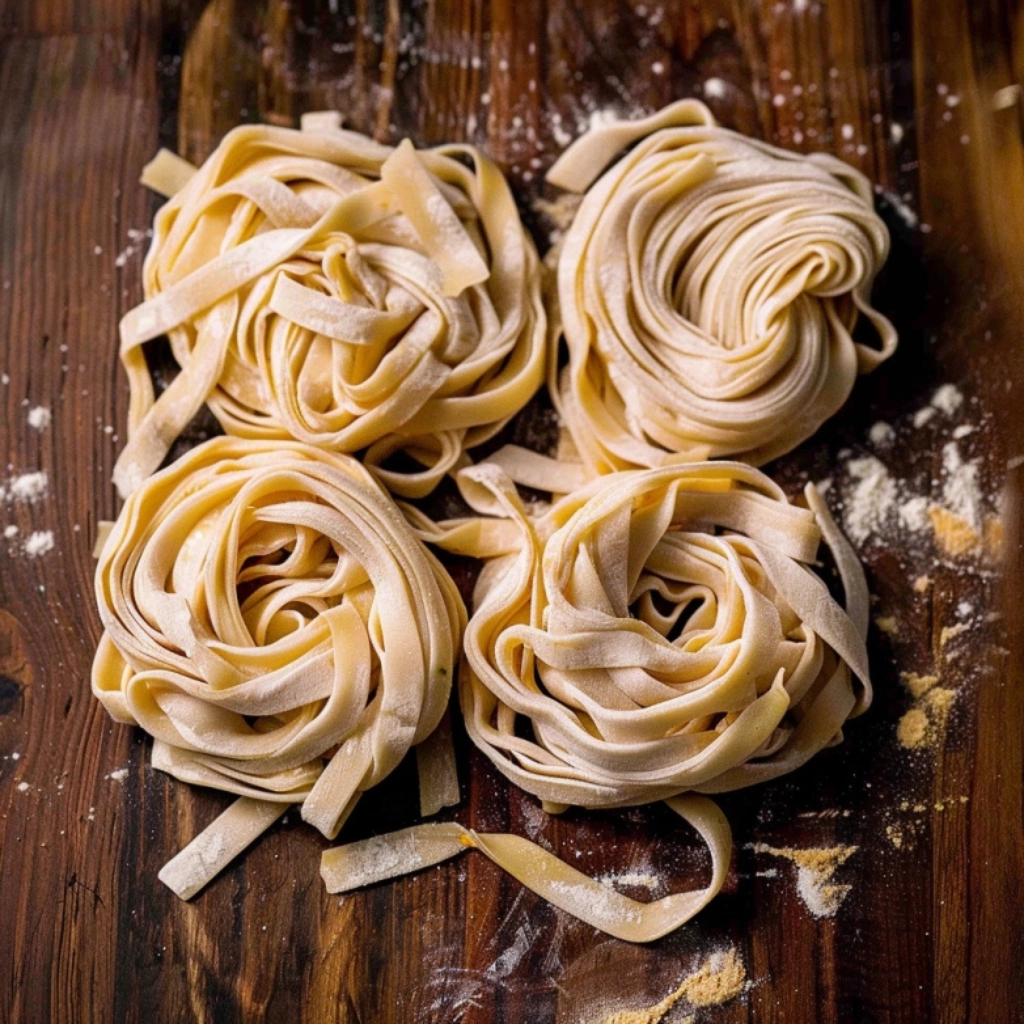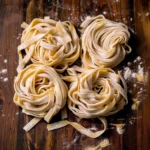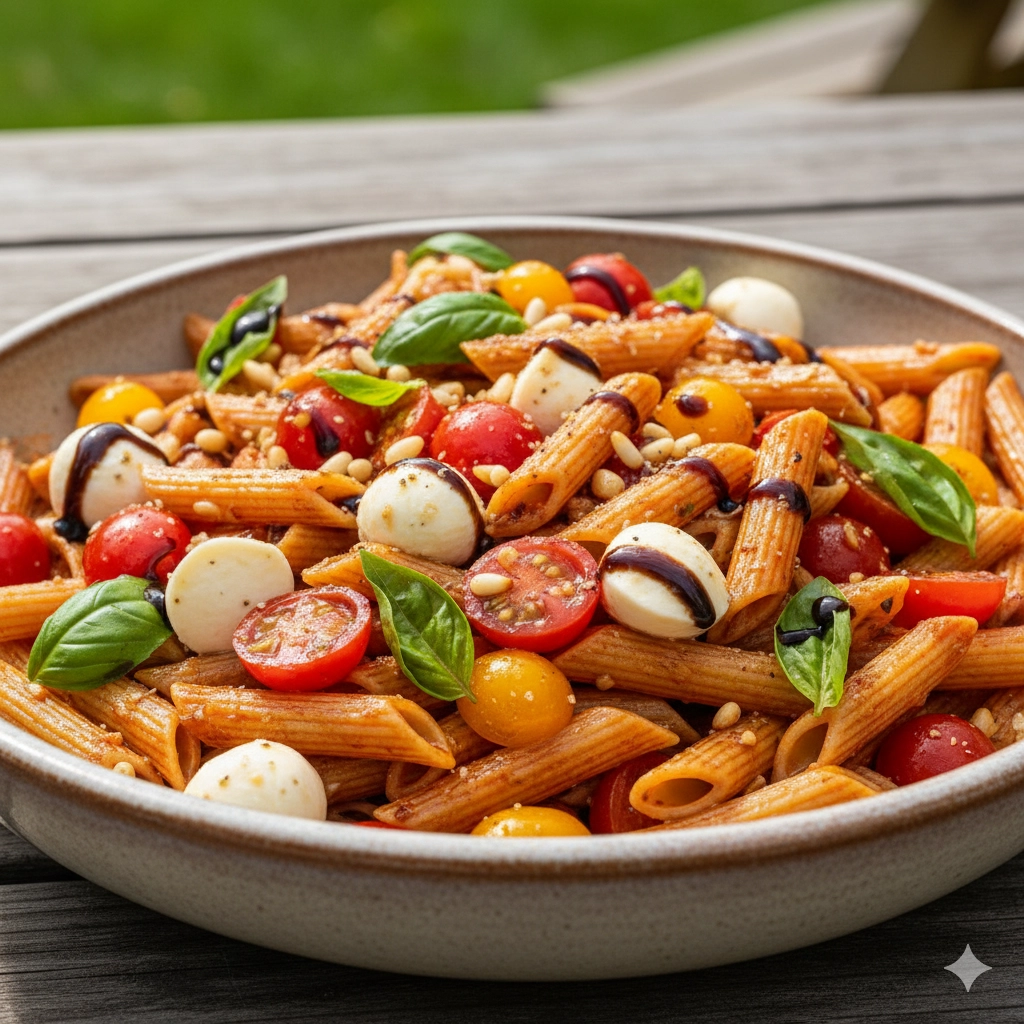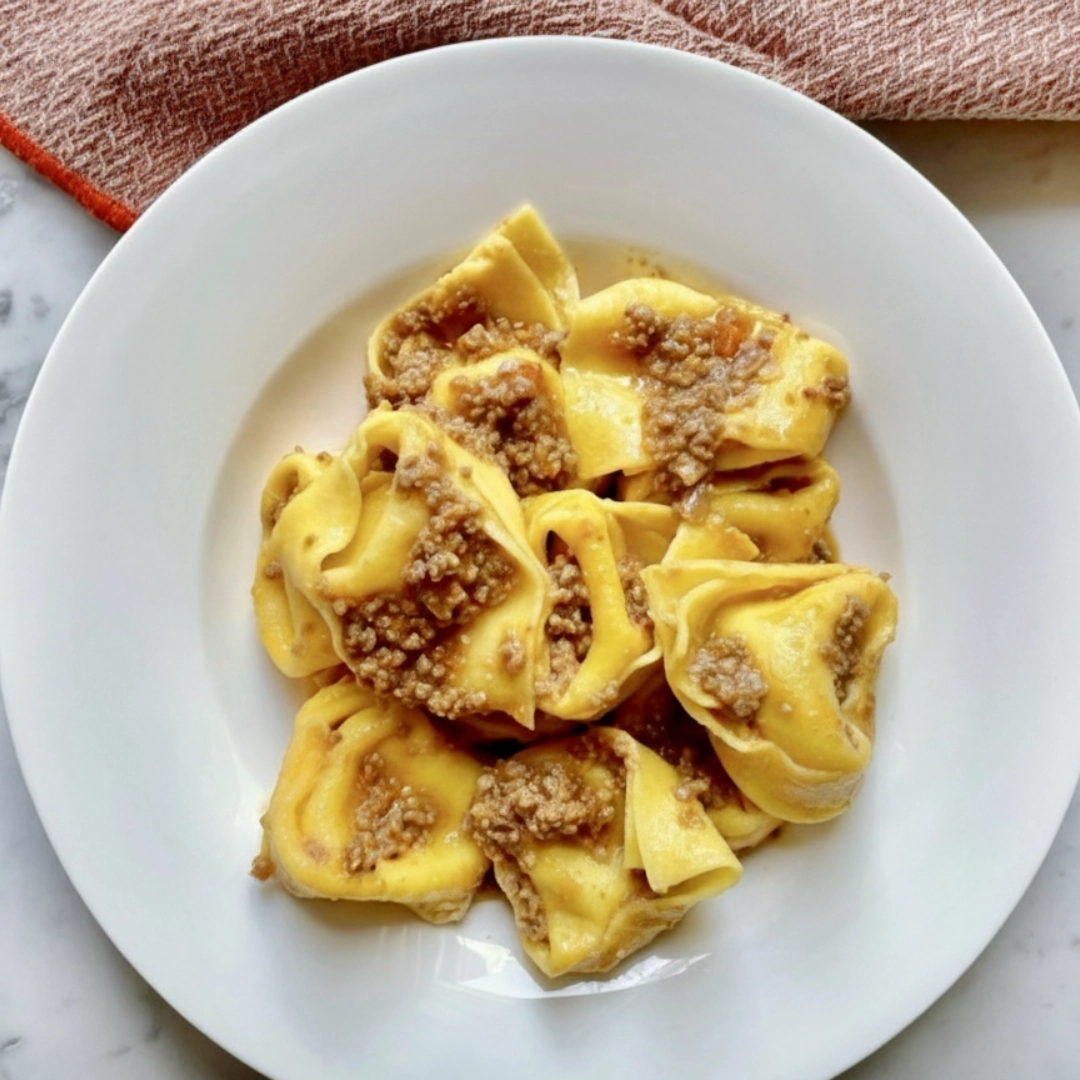I first fell in love with making sourdough pasta one Sunday afternoon when my grandmother pulled out her old wooden board and a jar of bubbling starter. The kitchen filled with the scent of flour and olive oil as she taught me how to knead pasta by hand “feel the dough,” she’d say, “it will tell you when it’s ready.” Years later, after experimenting with sourdough bread and homemade noodles, I decided to bring the two worlds together and the result was something truly special.
This homemade sourdough pasta recipe delivers all the comforting texture of fresh pasta with a subtle tang that only fermentation can create. It’s simple enough for beginners yet endlessly adaptable use your active starter or discard, roll it thin or thick, and turn it into fettuccine, ravioli, lasagna sheets, or rustic pappardelle.
Beyond its flavor, sourdough pasta offers real nutritional and digestive benefits. The natural fermentation process helps break down gluten and phytic acid, making it gentler on your stomach while deepening the pasta’s golden color and earthy aroma. Plus, it’s a wonderful way to use up sourdough discard that might otherwise go to waste.
Whether you’re making dinner for two or preparing homemade noodles for a weekend family meal, this recipe captures the old-world art of pasta-making no fancy equipment, no shortcuts, just honest ingredients and a little time. Let’s dive into how to make sourdough pasta step-by-step so you can taste that same wholesome tradition in your own kitchen.
Table of Contents
Why You’ll Love This Sourdough Pasta
There are so many reasons to fall in love with sourdough pasta. It’s wholesome, flavorful, and deeply satisfying to make from scratch. Each bite has a gentle tang and a chewy texture that you can’t find in store-bought noodles. If you enjoy working with sourdough bread dough, you’ll appreciate the same living quality in this recipe it feels alive in your hands.
Here’s why this recipe stands out:
- Delicious flavor: The fermentation from the starter adds a subtle sourness that balances beautifully with rich sauces and olive oil.
- Better for your body: Sourdough fermentation helps break down gluten and phytic acid, making the pasta easier to digest and more nutritious.
- Simple ingredients: You only need flour, eggs, sourdough starter or discard, salt, and olive oil. No special tools or pasta machine required.
- Flexible timing: You can make it fresh the same day or ferment it overnight for a deeper, more complex flavor.
- Perfect for using discard: Instead of tossing out your sourdough discard, turn it into something delicious and homemade.
If you love pasta with a homemade touch, you’ll find that this sourdough version brings a warm, rustic charm to your table. It’s an ideal weekend project that rewards you with the taste of slow, mindful cooking.
What Is Sourdough Pasta?
Sourdough pasta is a simple twist on traditional homemade pasta, using sourdough starter or discard instead of plain water or part of the liquid. The starter adds a light tangy flavor and improves the texture of the dough. It’s still made with familiar ingredients flour, eggs, salt, and a touch of olive oil but the fermentation process gives it something extra.
The main difference between regular pasta and sourdough pasta lies in fermentation. When you let the dough rest for several hours, the wild yeasts and beneficial bacteria from your sourdough starter begin to break down gluten and starches in the flour. This process:
- Deepens the flavor, adding gentle sour notes
- Improves digestibility
- Increases nutrient availability
- Gives the dough a silky, pliable feel that rolls out beautifully
You can use either active sourdough starter or sourdough discard for this recipe.
- Active starter adds a bit more rise and mild tang.
- Discard has a stronger, more mature sour flavor and is a great way to reduce kitchen waste.
If you’ve ever made sourdough bread, this pasta follows the same principle. The fermentation gives you a living dough that develops flavor naturally over time. Whether you roll it by hand or use a pasta machine, the result is a wholesome, flavorful noodle that’s every bit as special as it sounds.
Key Ingredients You’ll Need
This sourdough pasta is built on just a handful of pantry staples. Each ingredient plays a small but important role in creating a soft, elastic dough with the right balance of flavor and texture.
Sourdough Starter or Discard
You can use either an active starter or sourdough discard. Active starter will give a milder flavor, while discard adds a more noticeable tang. Both work beautifully.
- Tip: If your starter is very thick, add a teaspoon of water to loosen it before mixing.
- Use starter at 100% hydration (equal parts flour and water by weight).
Flour
All-purpose flour makes a soft, easy-to-roll dough that’s perfect for beginners. You can also blend flours to suit your taste:
- Whole wheat flour adds nutty flavor and more fiber.
- Spelt or einkorn flour create a rustic texture.
- Semolina flour adds structure and bite for shaped noodles like fettuccine or lasagna sheets.
Eggs
Eggs give the dough richness and help it hold together. Use large eggs at room temperature for best results. If you’d like to make it egg-free, substitute with 2 tablespoons of water and 1 teaspoon of olive oil per egg for a firmer, vegan-style dough.
Salt
Salt brings out the natural flavors of the grains and the sourdough. You can adjust it to taste or leave it out if you’re watching sodium intake.
Olive Oil
A spoonful of olive oil keeps the dough supple and adds a smooth mouthfeel to the pasta once cooked. Any neutral oil like avocado or grapeseed oil can be used if preferred.
Water
You may need just a tablespoon or two of water to bring the dough together. Add it gradually so the dough doesn’t get sticky. The right texture is firm but pliable, like soft clay.
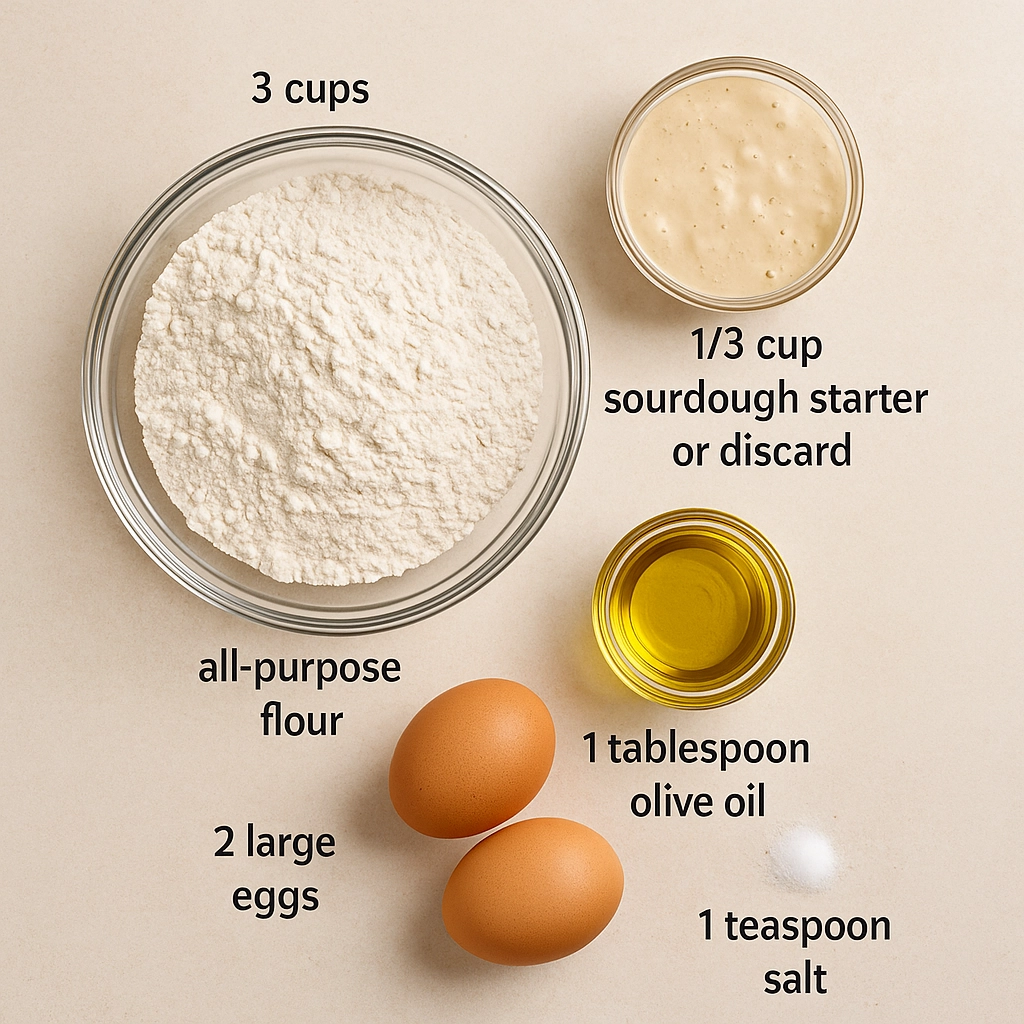
Step-by-Step: How to Make Sourdough Pasta from Scratch
This method works whether you’re mixing by hand or using a stand mixer. The dough comes together easily and rewards you with soft, flavorful noodles that cook in minutes.
Step 1: Mix the Dough
Place 3 cups of flour on a clean surface or in a large mixing bowl.
In a separate bowl, whisk together ⅓ cup sourdough starter or discard, 2 large eggs, 1 tablespoon olive oil, and 1 teaspoon salt.
Pour the wet ingredients into the flour and use a fork to combine until large clumps form.
If the mixture looks too dry, add water one teaspoon at a time until it starts to hold together. It should feel firm and only slightly tacky.
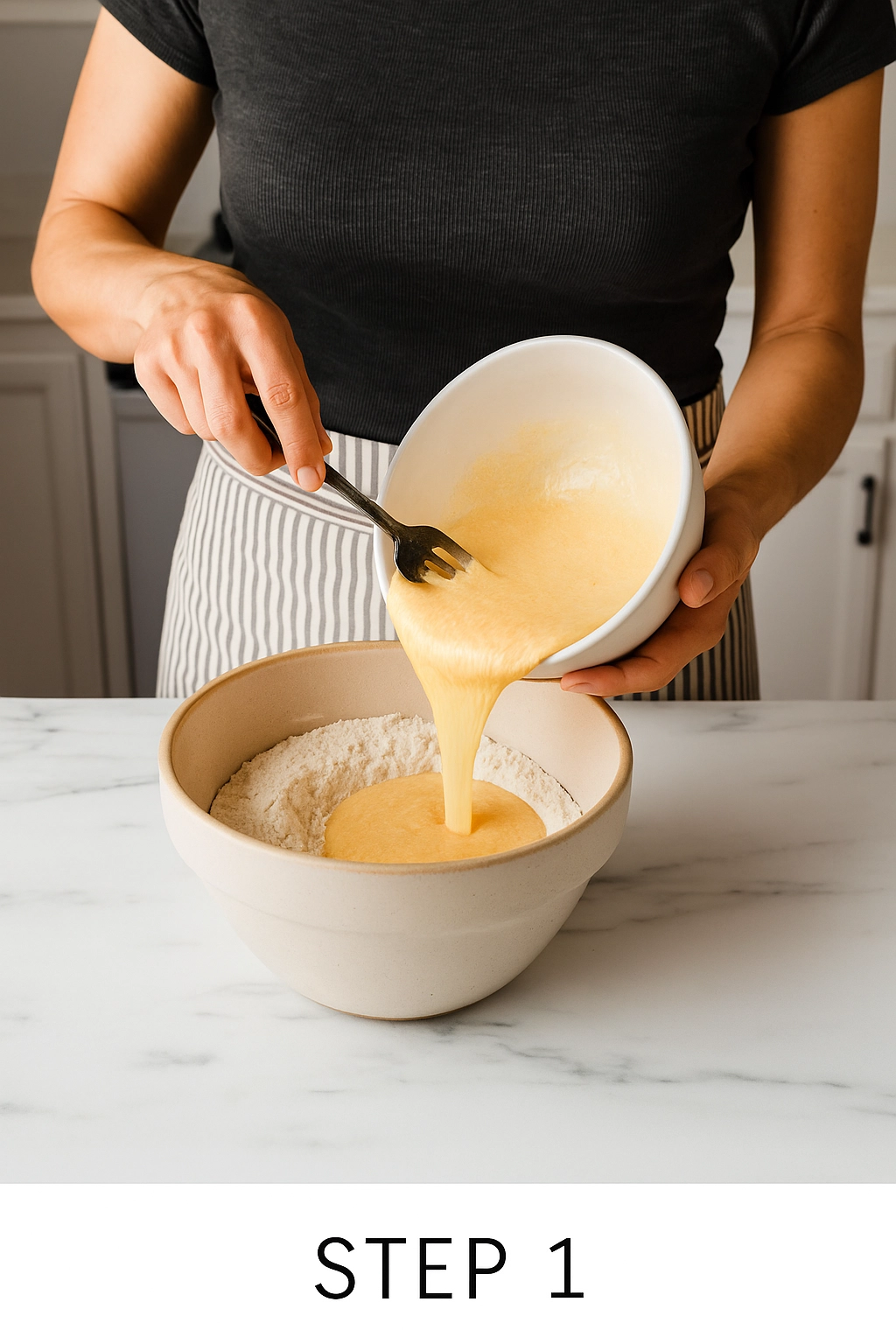
Step 2: Knead Until Smooth
Transfer the dough to a lightly floured work surface. Knead for 8 to 10 minutes until it feels smooth, elastic, and no longer sticky.
If you’re using a stand mixer, attach the dough hook and mix on low speed for the same amount of time.
Tip: If the dough tears easily or feels too stiff, cover it and let it rest for 10 minutes before kneading again.
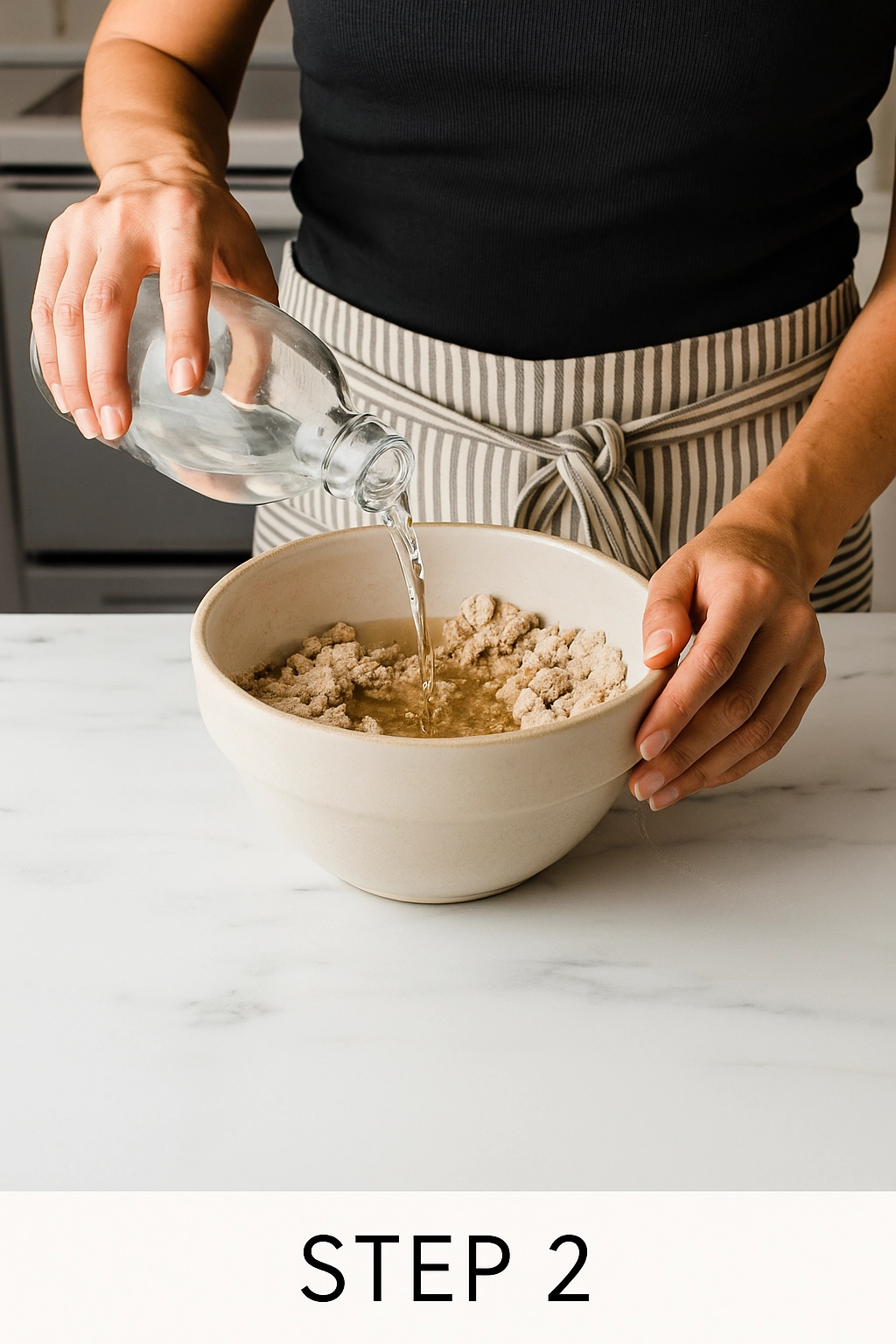
Step 3: Rest or Ferment the Dough
Shape the dough into a disc and wrap it tightly in plastic wrap.
- For same-day pasta, let it rest at room temperature for 1 hour.
- For better flavor and easier digestion, let it ferment for up to 24 hours in the refrigerator or at cool room temperature.
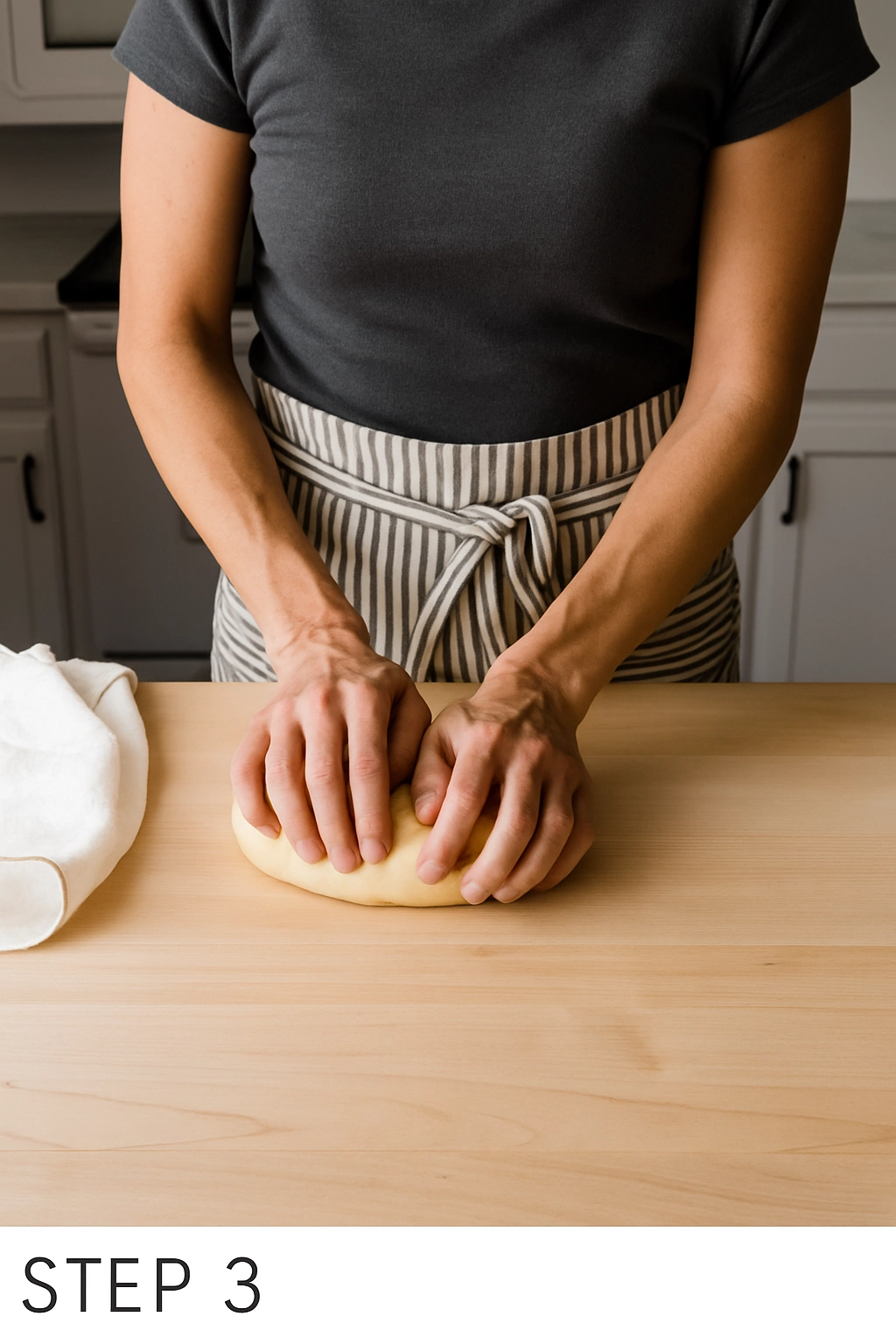
During this time, the gluten relaxes, making the dough easier to roll and shape.
Step 4: Roll and Cut the Pasta
Divide the dough into four equal pieces. Keep the pieces you’re not using covered to prevent drying.
Dust your work surface with flour and roll one piece at a time using a rolling pin or pasta machine.
Aim for a thin sheet that’s slightly translucent. For thickness guidelines:
- Spaghetti: ⅛ inch
- Fettuccine: ⅛ inch
- Pappardelle: 1/16 inch
- Lasagna or ravioli: 1/16 inch
Once rolled, dust both sides lightly with flour. Roll the sheet into a loose log and cut into strips using a knife, pizza cutter, or pasta wheel.
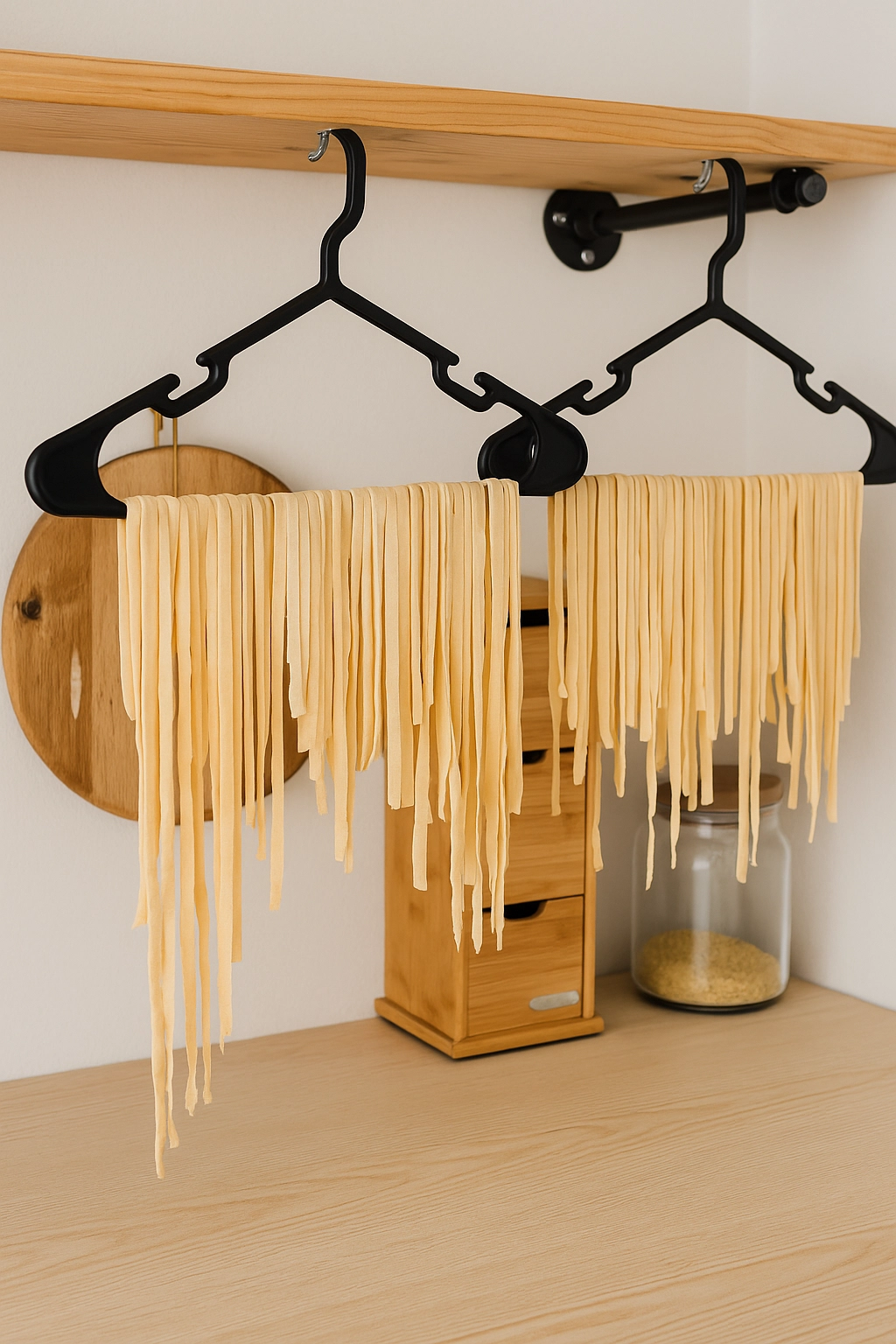
Step 5: Cook, Dry, or Store
- To cook: Bring a large pot of salted water to a boil. Add the pasta and cook for 4 to 5 minutes, or until tender but still slightly firm.
- To dry: Hang noodles on a drying rack or clean hangers for about 24 hours until completely dry and brittle.
- To store: Keep fresh pasta in the refrigerator for up to 2 days, or freeze for up to 8 months.
Tip: Frozen pasta can be cooked directly from the freezer just add an extra minute or two to the boiling time.
Pro Tips for Perfect Sourdough Pasta
After making sourdough pasta many times, I’ve learned a few tricks that guarantee consistent results every time. These small adjustments can turn a good batch into a great one.
1. Check Your Dough Hydration
The most common issue is dough that’s either too dry or too wet.
- If it feels crumbly, add a few drops of water and knead again.
- If it’s sticky, sprinkle a little flour and fold it in gently.
The dough should feel soft, pliable, and easy to roll without sticking to your hands.
2. Let It Rest
Even a short rest helps. Gluten relaxes, which makes the dough smoother and easier to handle. If you plan to ferment it overnight, store it in a sealed container instead of plastic wrap so it has room to expand.
3. Use Plenty of Flour When Rolling
Dust both sides of the dough before passing it through a pasta roller or rolling pin. This keeps the sheets from sticking and tearing.
4. Adjust Fermentation for Flavor
A longer ferment (up to 24 hours) gives a stronger sourdough flavor and slightly softer texture. A short rest gives you a milder, fresher taste. Both are delicious, so choose based on your preference.
5. Customize the Flavor
You can easily infuse this pasta with color or taste by blending herbs, vegetables, or spices into the dough:
- Add 1 tablespoon of spinach or beet puree for a vibrant hue.
- Stir in minced basil, garlic powder, or cracked black pepper for extra flavor.
- For richer pasta, use one egg yolk in place of a teaspoon of water.
6. Avoid Overcooking
Fresh pasta cooks quickly. Start checking for doneness after 4 minutes. Overcooked sourdough pasta can lose its chewy bite and turn soft.
7. Mix Flours for Texture
If you like more structure, replace ½ cup of all-purpose flour with semolina. It adds that classic Italian firmness to the bite.
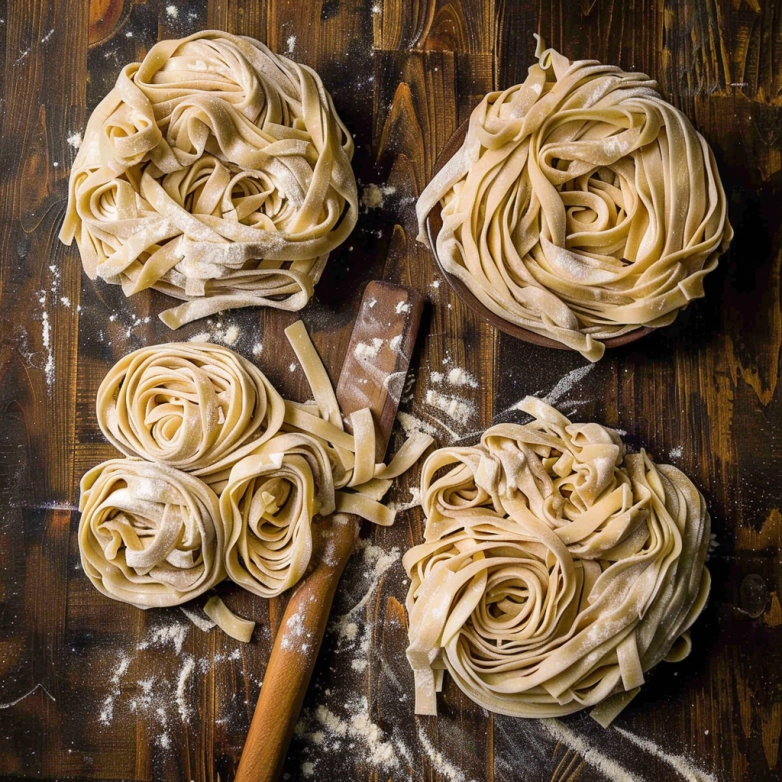
Serving Ideas
Sourdough pasta has a subtle tang and firm texture that pairs beautifully with almost any sauce. It’s the kind of noodle that stands out even with the simplest ingredients. Whether you prefer something light and herby or rich and creamy, this pasta is ready for it all.
Here are a few of my favorite ways to serve it:
- Classic tomato and basil: Toss freshly cooked pasta with a drizzle of olive oil, crushed garlic, and sweet basil. For a restaurant-style twist, try this Cheesecake Factory Tomato Basil Pasta.
- Filled pasta dishes: Use this dough to make Mezzaluna Pasta or homemade ravioli stuffed with ricotta and spinach.
- Vegetable-forward recipes: Pair your sourdough noodles with garden vegetables like zucchini and cherry tomatoes, just like in Pasta with Zucchini and Tomatoes.
- For gluten-sensitive cooks: If you’re experimenting with flour alternatives, see how we adapt traditional recipes in the Gluten-Free Pasta Recipe guide.
You can also keep it simple — a knob of butter, a sprinkle of parmesan, and a few grinds of black pepper are sometimes all you need. The sourdough’s natural flavor shines through even the simplest sauces.
Storage and Freezing Instructions
One of the best things about sourdough pasta is how well it keeps. Whether you’re prepping ahead for a busy week or storing extra batches from a weekend cooking session, this pasta holds its texture and flavor beautifully when stored the right way.
To Refrigerate
Fresh sourdough pasta can be kept in the refrigerator for up to 2 days.
- Lightly dust the noodles with flour to prevent sticking.
- Place them in an airtight container or wrap tightly in plastic.
- When ready to cook, drop them directly into boiling salted water — no need to dry them first.
To Freeze
Freezing is the best option if you want to keep your pasta for longer.
- Arrange the noodles in a single layer on a parchment-lined baking sheet.
- Freeze for 1 hour or until the pieces are firm.
- Transfer the frozen pasta to a freezer-safe bag or container, label it, and store for up to 8 months.
When cooking frozen pasta, add it straight to boiling water and increase the cooking time by about 1 to 2 minutes.
To Dry
Drying sourdough pasta gives it a long shelf life and deepens the flavor slightly.
- Hang noodles over a pasta rack or even clean clothes hangers.
- Let them dry in a cool, dry area for 24 hours or until they snap cleanly when bent.
- Store in airtight containers or glass jars for up to 2 months.
Drying time can vary depending on humidity and noodle thickness. If it bends instead of snapping, give it more time to air-dry before sealing it up.
Common Mistakes & Troubleshooting
Even though sourdough pasta is simple to make, a few small missteps can change the texture or flavor. Here’s how to troubleshoot the most common problems and make every batch smooth, elastic, and delicious.
1. The Dough Is Too Dry
If your dough crumbles or doesn’t come together easily, it needs a touch more moisture.
- Add water one teaspoon at a time while kneading.
- Knead thoroughly so the moisture distributes evenly.
Flour types can vary in how much water they absorb, so adjustments are normal.
2. The Dough Is Too Sticky
Sticky dough can be tricky to roll or cut.
- Sprinkle a small amount of flour on your hands and work surface.
- Let the dough rest for 10 minutes to allow the flour to hydrate fully.
Avoid adding too much flour at once or the pasta will turn tough.
3. Pasta Breaks While Rolling
This usually means the gluten isn’t relaxed enough.
- Cover the dough and rest it for another 10 to 15 minutes before rolling again.
- Make sure your resting period after kneading was at least 1 hour.
4. The Flavor Is Too Tangy
If your pasta tastes overly sour, the dough fermented too long or sat in a warm environment.
- Next time, reduce fermentation to 8–12 hours.
- Keep it in the refrigerator for a slower, milder ferment.
5. Pasta Is Tough or Rubbery After Cooking
Over-kneading or overcooking can cause toughness.
- Knead just until smooth and elastic.
- Boil only 4–5 minutes for fresh pasta, checking for tenderness early.
6. Pasta Sticks Together After Cutting
Fresh pasta sticks easily if it’s not dusted well or left to rest.
- Dust the cut noodles with flour and gently toss them to coat.
- Let them rest for 30 minutes before boiling or storing.
Each of these small adjustments will help you master the feel of the dough. With practice, you’ll start to recognize when your pasta is just right smooth, soft, and full of life.
Nutrition Information
Homemade sourdough pasta is rich in complex carbohydrates and offers a balanced mix of protein and healthy fats from eggs and olive oil. The fermentation process can also make nutrients like iron, magnesium, and B vitamins easier to absorb compared to unfermented pasta.
Here’s an approximate breakdown per 1-cup serving (about 4 ounces of cooked pasta):
| Nutrient | Amount |
|---|---|
| Calories | 210 kcal |
| Carbohydrates | 38 g |
| Protein | 7 g |
| Fat | 3 g |
| Fiber | 2 g |
| Sodium | 200 mg |
These numbers will vary slightly depending on the flour and starter you use.
Note: This content is for educational purposes only and does not replace professional dietary or medical advice.
FAQs About Sourdough Pasta
1. Can I make sourdough pasta without eggs?
Yes. Replace each egg with 2 tablespoons of water and 1 teaspoon of olive oil. The dough will be slightly firmer and less rich, but it still rolls and cooks beautifully.
2. What type of sourdough starter works best?
A 100% hydration starter (equal parts flour and water by weight) is ideal. Both all-purpose and whole wheat starters work fine. The flavor will vary slightly depending on the flour used in your starter.
3. Why is my pasta dough tough?
Tough pasta often comes from over-kneading or not resting the dough long enough. After kneading, let the dough rest for at least an hour so the gluten can relax before rolling.
4. How long should I ferment the dough for the best flavor?
For mild sourness, rest the dough for about 1 hour. For a deeper flavor and improved digestibility, ferment for 12–24 hours in the refrigerator.
5. Can I make flavored or colored sourdough pasta?
Absolutely. You can blend in ingredients like spinach puree, beet juice, squid ink, or turmeric for natural color and flavor. Start with a tablespoon and adjust as needed.
6. How do I know when my sourdough pasta is fully dried?
Dried pasta should snap cleanly when bent. If it bends or feels leathery, let it dry longer in a cool, dry area before storing.
7. Can I use sourdough pasta dough for stuffed recipes like ravioli or tortellini?
Yes. This dough holds up beautifully for filled pastas. Roll it thin (about 1/16 inch), keep the edges floured, and seal with a small brush of water before cooking.
More Pasta Recipes to Try
If you loved making sourdough pasta, you’ll enjoy exploring these other comforting pasta dishes. Each one offers a fresh way to bring homemade flavor to your table:
- Cheesecake Factory Tomato Basil Pasta – Creamy tomato sauce with a hint of basil and parmesan.
- Mezzaluna Pasta – Half-moon pasta stuffed with rich, savory filling.
- Gluten-Free Pasta Recipe – A great option for gluten-sensitive eaters who still crave homemade noodles.
- Pasta with Zucchini and Tomatoes – Light, fresh, and perfect for summer meals.
Each of these recipes complements the rustic charm of sourdough pasta and helps you build a diverse pasta repertoire at home.
Love simple, flavorful recipes?
Pinterest: Explore gorgeous food boards, meal prep hacks, and family-friendly favorites — Flavour Recipe on Pinterest
Homemade Sourdough Pasta Recipe (No Special Equipment Needed)
This homemade sourdough pasta recipe combines simple ingredients with natural fermentation for rich flavor and better texture. Perfect for using sourdough starter or discard.
- Prep Time: 1 hour
- Cook Time: 5 mins
- Total Time: 1 hour 20 mins
- Yield: 4 servings 1x
- Category: Main Dish
- Method: Handmade
- Cuisine: Italian
Ingredients
3 cups all-purpose flour
1/3 cup sourdough starter or discard
2 large eggs
1 tablespoon olive oil
1 teaspoon salt
1–2 tablespoons water
Instructions
1. In a bowl, whisk together sourdough starter, eggs, olive oil, and salt.
2. Pour into flour and mix until large clumps form. Add water one teaspoon at a time until dough holds together.
3. Knead on a floured surface for 8–10 minutes until smooth and elastic.
4. Wrap dough and rest 1 hour at room temperature, or refrigerate up to 24 hours for deeper flavor.
5. Divide into four pieces. Roll each thin and cut into desired shapes.
6. Boil in salted water for 4–5 minutes until tender. Drain and serve with sauce.
Notes
You can use either active starter or sourdough discard.
Longer fermentation gives stronger flavor and improved digestibility.
Store fresh pasta for 2 days in the refrigerator or freeze for up to 8 months.
Nutrition
- Serving Size: 1 cup
- Calories: 210
- Sugar: 0g
- Sodium: 200mg
- Fat: 3g
- Saturated Fat: 1g
- Unsaturated Fat: 2g
- Trans Fat: 0g
- Carbohydrates: 38g
- Fiber: 2g
- Protein: 7g
- Cholesterol: 90mg

